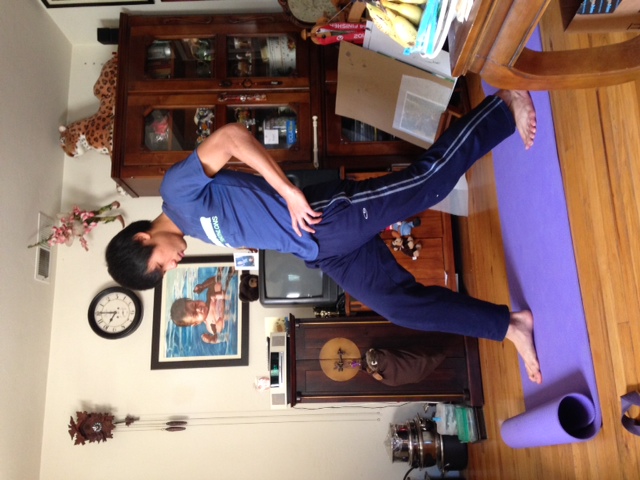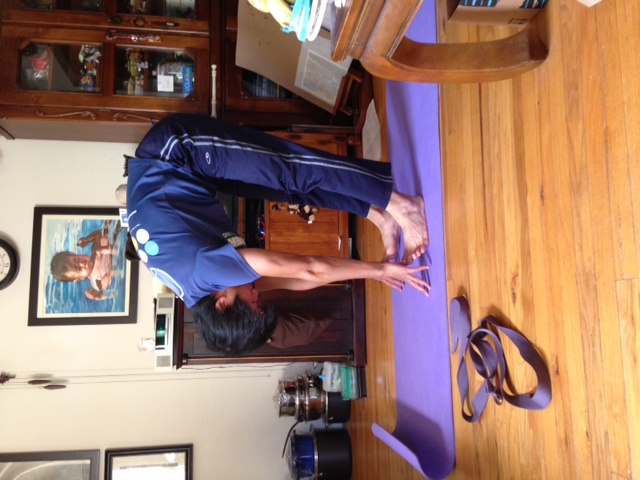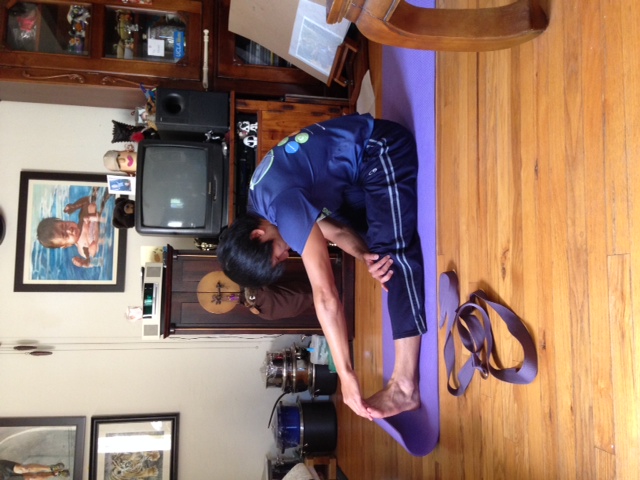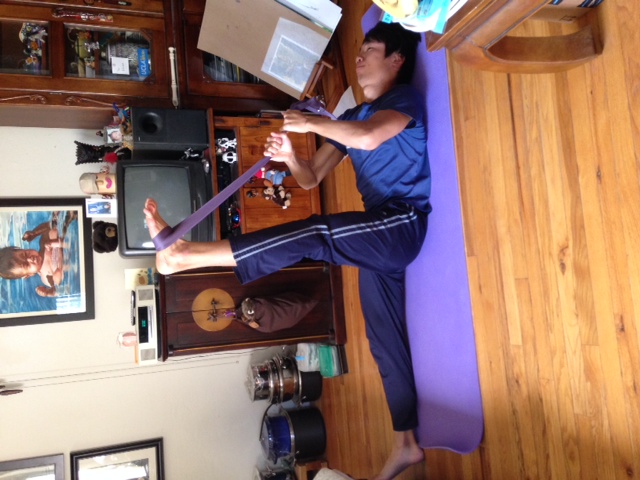Running, like the other three sports, presents its unique challenge. It's the sport that people have most challenge staying healthy in, from my observation. I do acknowledge that swimming(shoulder injuries), and cycling (knee, hip, etc), but most of the time people swim and bike because they can't run. Shin splints, bad knee, IT band, hip issues, are all common household names amongst endurance runners. And while some people do successfully get to peak shape, they fail to hold it for long due to injury or fatigue.
I've seen a lot of my good friends that are extremely talented thwarted with injuries. I've also made some mistakes of my own (IT band injury last year resulted from complication of bad bike crash at Vineman 70.3 '15), but I stayed relatively healthy compared to my competitors and friends that I trained with over the years. I've taken lessons learned from my friend and by observing what works for people that do stay healthy and competitive consistently over the years.
Part I Preventing Injury
1. Never Shock the Body. Your body is very much like you. You don't like surprises. Sudden stressful situations makes us uncomfortable and distressed. The same with your body. Sudden increase in your mileage ( you ran 20 miles last week, and this week you suddenly ran 35 miles) is often what causes most people to be sidelined.
2. If you're just getting back into running, avoid running with people that are in shape or much faster than you at the moment. I often disappear for 3 months when I'm just getting back into shape. I don't want to be pressured into running fast or keeping up with people or running as far as them. If 4 miles feels exhausting to me, I'm gonna stop and take a nap. Once I get into shape, that's when I show up and push myself with people again. Take it slow, be patient, the fitness will come!
Here's an example for what I did to get back in shape after my injury:
First week, couple of 6x(2 minute easy running (9min pace) 1 minute walk.)
Second week, 6x(3min easy running, 1 minute walk)
Third week, 6x(4min easy running, 1 minute walk)
After I felt that there was no pain, I started running a couple of 40 minute runs on grass super easy. But see how I was extremely patient to get back into shape, taking no risk at all. You never want to take 2 steps forward and 1 step back. 2 weeks later I was running 5 mile runs at 6 minute pace. The fitness WILL COME!
3. Take care of small pains before they become big ones. Get a massage at least once or twice a month. It's hard to spend money on yourself for massages, chiropractic session, or physical therapy. It's a lot of money and most of the time, we feel like we're fine without it. But our muscles work quite hard and over time any imbalance can snowball into really bad biomechanical behavior. So at least once (ideally twice a month) get a massage to loosen up tight muscles, and get checked up.
4. Dedicate 20 min of everyday to stretching, foam rolling, and bit of self massage. Over the past 5 years, I've always dedicated at least 20min a day to stretching (my hips, quads, hamstrings). Here are the 5 main stretches I do before bedtime. Why do I do these stretches? You have to remember that each movement you produce is a result of contraction of a muscle. There's always a counter movement to that motion. Therefore there's another muscle on the other side that does the contraction which undo the first movement. Essentially whenever a muscle's contracting to move a limb, it is also pulling on the resistance of the relaxed muscle on the other side. The loser that muscle is, the less energy you use. Using smallest amount of energy possible to achieve the most work is the name of the game! Efficiency!
Part II Training
5. Mileage. This is HOTLY debated but general consensus is that without decent volume, you cannot become a great runner. Unless you're Jesse Thomas or someone who has a running background, or you're just a natural gazelle. What has worked best for me has been consistent miles for 4-5 days a week. They don't have to be crazy. For me personally they're 5-10 mile runs on average with a long run thrown in there. But I've seen competitive runners run 5-7 miles 4 times a week also with great success. The key is frequency and consistency over 2-3 months period of non stop running. If that means staying conservative and running 2-3 miles some days then do it. I do it just to stay in rhythm. Rhythm with running is also very important. The body gets in a groove where it knows how to use all your muscles in harmony to run the best. Once you take 3 or 4 days off it's when things go out of whack. Find out how much mileage you can handle without injuring yourself, and be consistent with it. That number for most people in school or a job or other commitments, is 25-50 miles a week from my observation.
6. Long Run. This like the long ride in cycling CANNOT BE SKIPPED. It can be skipped during taper weeks or when you absolutely can't run it. But during a build phase, you need at least 2-3 of these in order to build a foundation for all your other work outs (track, tempo, etc). The long run teaches your body how to run when tired and also use fat as fuel. We all burn a mixture of fat and carbs during activities. The goal with the long run is to increase fat in that mixture. In other words, also raise your aerobic threshold so you can stay aerobic for higher intensities down the road.
7. Variation of Pace. I have to credit my coach Keith McDonald for introducing this into my program. We have a lot of change of pace where we do (4min steady, 6 min hard, 4min steady) to make the body uncomfortable and become powerful at controlling and maintaining pace. Before I'd train hard at one or two zones (easy and hard lol), and I only got so fast through that type of monotonous training. The body needs stimulus like how some of us (like me) prefer to watch movies than read a script of the movie. Training needs to be interested and surprising sometimes in order for the body to adapt and get better.
8. Hill Running. I grew up around hills so I'm a little bias but hills are great for building strength (resistance training) and also improving your top end fitness without the stress of a track work out. Track work outs are high intensity and high impact on joints, muscles, etc. Where as hills can give you the same cardiovascular benefit but less harsh impact on the track. Do be careful with going downhill. Take downhills slow or walk them if you have to. The heavy impact of going downhill is something that you don't want excessively in your routine.
Some example of hill work outs I've done : 5-6x 3min hard (zone3-zone 4) up a 5% grade.
You can also find a route that has a total of 700-800 ft of climbing or less. When it gets more than 800 its when it becomes not beneficial in my opinion.
9. Biomechanics: Through trial and error I've studied, researched, experimented and learned a lot about running mechanics. I had a couple evolution of my running technique and each phase got me faster and closer and better. I've dropped times in all distances, (1 minute in 5k, 3 minutes in 10k, 9 minutes in half marathon). Here are the 4 most important things I've learned.
i. Good posture, forward lean. You want upper body to be tall and taut. There shouldn't much side to side movement. You want your upper body to be stiff and transfer all the energy from your push off into pushing you forward. Having a forward lean utilizes gravity to pull your forward as well and maintain your forward momentum.
ii. Arm Swing. When your legs swing back and forth to keep you moving, a lot of angular momentum is created. This means that your legs are trying to make your body rotate back and forth, side to side (with an axis that goes straight through top of your head down your spine). To counter balance this, your arm's there to create a counter angular motion that opposes your leg motion and keep your motion forward.
iii. Heel Lift. All elite runners have this quality. Shown below in the picture. All except your slowest pace, you should actively try to pick up your heels with your hamstring. This enables your leg swing to be more of a cycle and also prevents you from being quad dominant and encourages you to use your glutes (more on that below). The heel lift helps push your body forward and afterwards also bring your leg back so your hip flexors don't have to do any work to bring them back. More energy saved. Points.
iv. The push off motion should use the same muscle as the ones used for lunges, that is GLUTE DOMINANT RUNNING. This is my biggest breakthrough over the last year. I always tweak my technique every year and this is the one that had the most bang for the buck. A lot people are quad dominant runners (here in the states anyways). They push off by doing a firing action similar to that of knee extension. They're extending their legs straight and using their knee as a stress pivot point instead of driving from their hip and core, which has all the strong muscles, your a$$. And yes, your butt is money because it is very strong and doesn't get tired or injured as easily. Quad dominant running can lead to muscle imbalances and knee problems. I was a victim of IT band from quad dominant running and cycling. How do you fire your glutes? There are various exercises you can do, this one below is how I learned it:
Try "squeezing" your butt cheeks together. It will fire your glutes.
Once you learn how to control your glutes together, try to separate them with exercises like step ups and backward lunges.
10. Nutrition! You lose the most amount of fluids during running. I typically lose 2-3 pounds during an hour run depending on how hot it is. That's as lot of fluids (1 pound is 15 fluid oz approxmiately, that's a full water bottle dude). So if you can, replace fluids on the run, or drink lots of water with electrolytes afterwards. Preferably, they should also have calories (1-2 scoops of carbo pro to replenish glycogen storage). Also before runs, figure out your stomach and your meal schedule. If your run is 6+hours from your last feeding session, then have a small snack (clif bar with banana) 1 hour before the run for example. Some people can't handle that, so they need to eat far before and eat a lot. A lot of people suffer on runs just because their blood sugar and glycogen is running low. So feed yourself and be a happy runner!
Again, that's it, long article. hope it helps. If you have any input please feel free to comment (no that anyone has done that yet lol) but I appreciate you reading this is you made it this far. If you let me know I might just buy your coffee or hot chocolate. Any shoot if you have any questions about anything. I'm here to help and happy to help.
Spread the love for swimming, biking and running people! Until next time!











